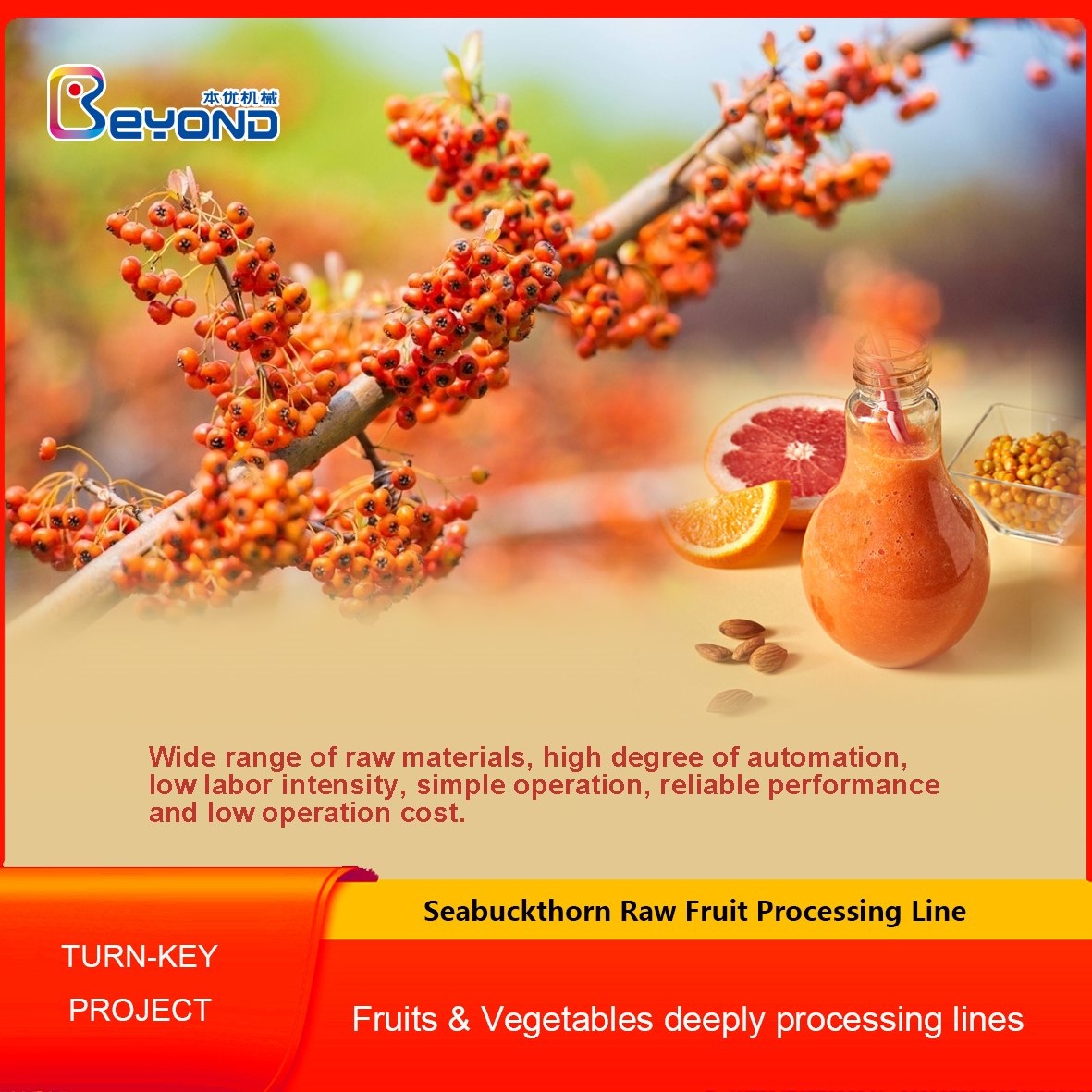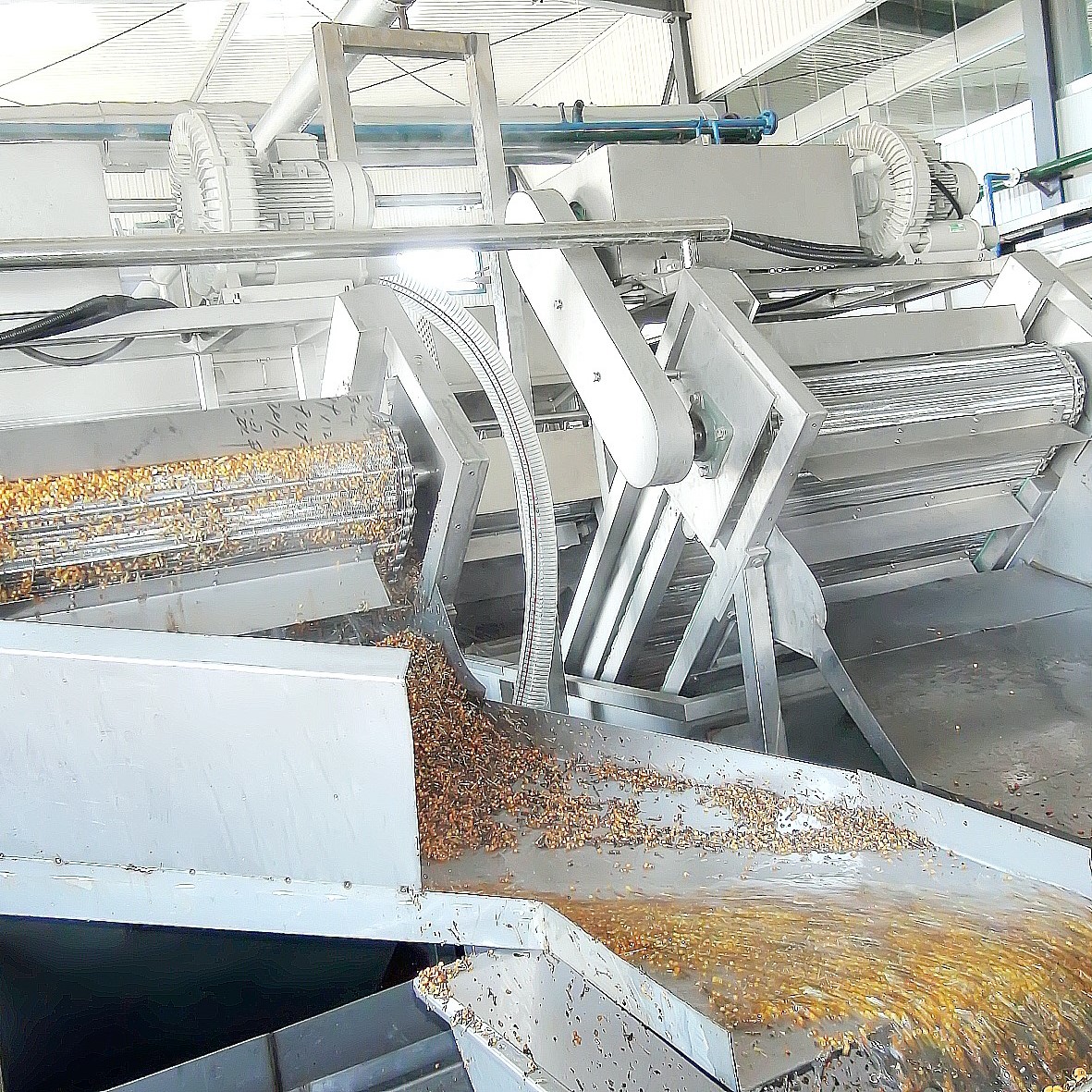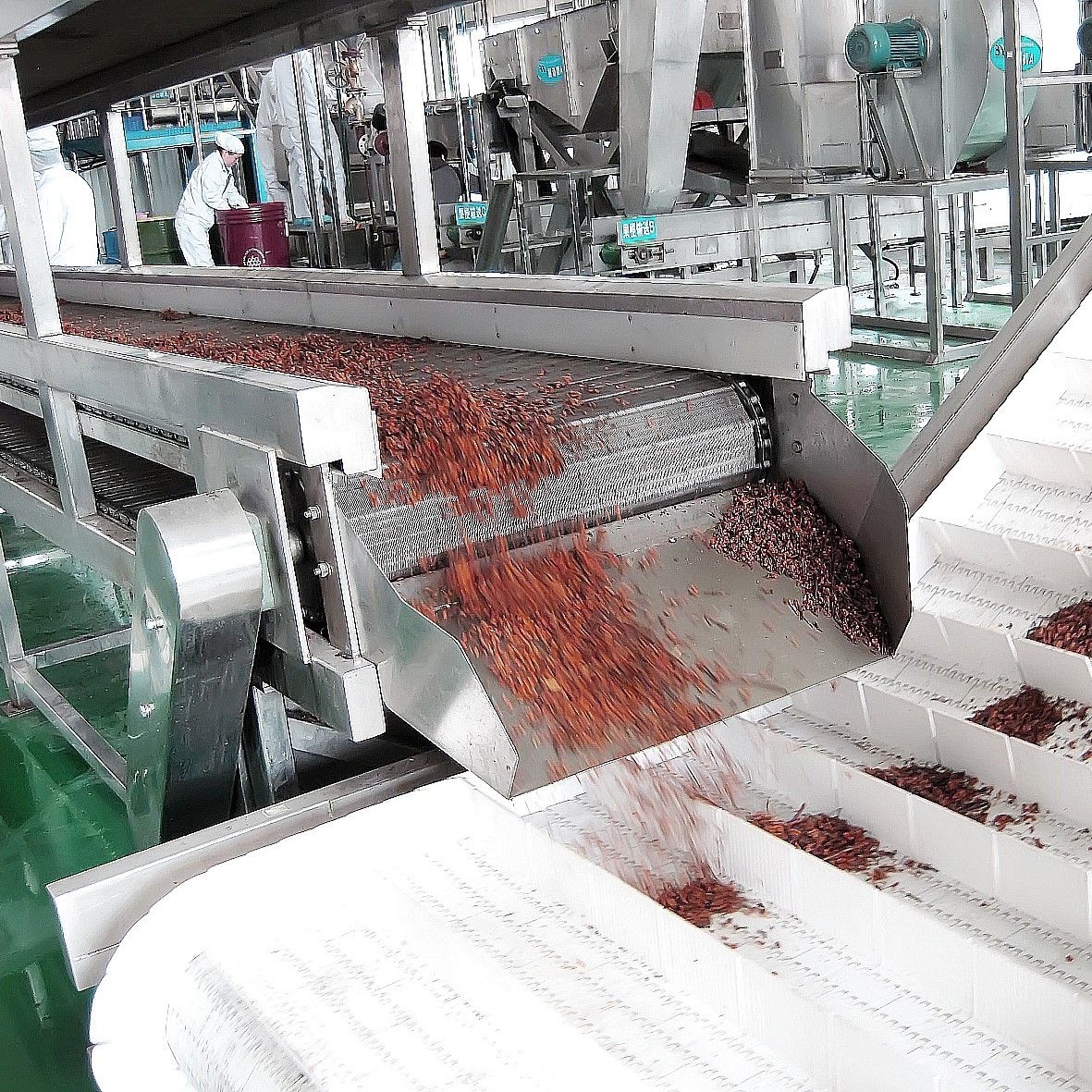
A seabuckthorn processing line is a series of equipment and machinery used to process seabuckthorn berries into various products. These processing lines are typically used in the food and beverage industry to produce juices, oils, extracts, and other seabuckthorn-based products.
The processing line generally consists of the following components:
Fruit Washing Machine: This machine is used to clean the seabuckthorn berries by removing dirt, debris, and any other impurities.
Berry Destemming Machine: This machine is used to remove the stems from the seabuckthorn berries, making them ready for further processing.
Berry Crushing Machine: This machine is used to crush the seabuckthorn berries, breaking them down into smaller pieces and releasing their juice.
Juice Extractor: This equipment extracts the juice from the crushed seabuckthorn berries. It typically uses a centrifugal force or a pressing mechanism to separate the juice from the pulp and seeds.
Juice Clarifier: This machine is used to clarify the extracted seabuckthorn juice by removing any remaining particles or impurities. It may employ methods such as filtration or settling to achieve this.
Pasteurizer: The pasteurizer heats the seabuckthorn juice to a specific temperature to kill any harmful microorganisms and extend its shelf life. It may use processes like steam heating or indirect heat exchange.
Juice Concentrator: This machine is used to concentrate the seabuckthorn juice by removing a portion of its water content. It helps enhance the flavor and viscosity of the final product.
Bottling or Packaging Machine: This equipment fills and seals the concentrated seabuckthorn juice or other products into bottles, cans, or other suitable packaging materials.
Labeling and Coding Machine: This machine applies labels with product information and codes to the packaged seabuckthorn products.
Packaging Line: This is the final stage of the processing line, where the packaged seabuckthorn products are boxed or palletized for storage or shipment.
These are the key components of a seabuckthorn processing line, but the exact configuration and machinery used may vary depending on the specific requirements and scale of production.

Raw materials and products of seabuckthorn processing line
1. Raw materials
Seabuckthorn fruit is rich in vitamins, minerals and antioxidants, and its processing requires careful selection and processing of raw materials. The following are detailed raw material requirements:
1. Seabuckthorn fruit
• Variety selection: Select seabuckthorn varieties suitable for processing, such as Mongolian seabuckthorn, Chinese seabuckthorn, etc. Different varieties of seabuckthorn fruit have different nutritional components and flavor characteristics.
• Quality standards: Ensure that the seabuckthorn fruit is moderately mature, free of pests and diseases, and free of rot. The fruit should be kept intact as much as possible to avoid damage to reduce the risk of contamination.
• Picking time: Usually picked in autumn or early winter, when the fruit is most nutritious.
2. Water
• Use: Used to wash seabuckthorn fruit and prepare seabuckthorn products.
• Water quality requirements: It must meet the drinking water standards. It is recommended to use purified water sources to ensure safety and hygiene.
3. Food additives (optional)
• Vitamin C (ascorbic acid): Used to prevent oxidation and maintain the color and taste of seabuckthorn products.
• Stabilizers: such as xanthan gum, pectin, etc., used to improve the texture and stability of sea buckthorn juice and prevent precipitation.
• Sweeteners: such as sucrose or stevioside, adjust the sweetness according to market demand.
• Flavors: natural or synthetic flavors, used to enhance the aroma of sea buckthorn products.
II. Products
The main products of the sea buckthorn processing production line include sea buckthorn juice, sea buckthorn oil, sea buckthorn powder and other forms. The following are detailed product types and their characteristics:
1. Sea buckthorn juice
•Pure sea buckthorn juice
•Features: No other ingredients are added, retaining the original flavor and nutrition of sea buckthorn fruit.
•Production process: Cold pressing or hot pressing technology is used to ensure that the natural ingredients in sea buckthorn are retained to the maximum extent.
•Applicable people: consumers who pay attention to health and pursue natural drinks.
•Concentrated and reduced sea buckthorn juice
•Features: Made by concentration and reduction process, it is easy to transport and store.
•Production process: First concentrate the sea buckthorn juice to a certain concentration (such as 65-70 Brix), and then dilute it with water to restore it to the original juice state.
• Applicable people: widely used in the beverage industry, as a raw material for further processing.
• Prepare sea buckthorn juice
• Features: add appropriate amount of water, sugar, vitamins and other ingredients to pure sea buckthorn juice to adjust the taste and nutritional content.
• Production process: mix in a mixing tank, fill after homogenization.
• Applicable people: meet the needs of consumers with different taste preferences.
2. Sea buckthorn oil
• Features: rich in unsaturated fatty acids such as Omega-3, Omega-6, Omega-7 and Omega-9, with high nutritional value and medicinal value.
• Production process: cold pressing or supercritical carbon dioxide extraction technology is used to ensure maximum retention of active ingredients.
• Applicable people: used in health care products, skin care products and other fields, suitable for consumers with special health needs.
3. Sea buckthorn powder
• Features: dry the sea buckthorn fruit and grind it into powder for easy storage and transportation.
• Production process: use low-temperature freeze-drying technology to ensure that nutrients are not lost.
• Applicable people: used in food additives, health care products, functional foods and other fields, suitable for consumers who have needs for convenience and nutrition.
4. Functional seabuckthorn products
•Features: Add specific functional ingredients, such as dietary fiber, probiotics, minerals, etc., to seabuckthorn products to give them specific health benefits.
•Production process: Additional functional ingredients need to be added and strict quality control is required.
•Applicable groups: Consumers with special health needs, such as improving immunity and regulating the stomach.
1.A wide range of raw materials, this production line is suitable for all kinds of large and small fruit Seabuckthorn;
2. The configuration of production line is flexible, and different functional equipment, such as enzymatic hydrolysis, membrane filtration and concentration equipment, can be flexibly configured according to different final product requirements of customers;
3. According to different investment amount and product positioning of customers, customers can configure ordinary, middle end or high-end products according to their own requirements;
4. The final product has good flavor, bright color and high yield;
5. The whole line has high degree of automation, low labor intensity, simple operation, reliable performance and low operation cost;
6. The whole production line adopts sanitary design, with thorough cleaning and high hygiene level.
Technical parameter
Raw material: large or small fruit Seabuckthorn (with or without branches)
Final products: concentrated juice, clear juice, turbid juice, sea buckthorn oil
Capacity: 20 t / D - 2000 t / D
Fruit juice yield: ≥ 90%
Solid content: 10 ~ 15brix
Packaging: sterile bag / glass bottle / PET bottle / roof bag / Tetra Pak
Technical parameter of 1000kg per hour seabuckthorn juice, pulp, and seeds oil line:
|
Flow NO.
|
Equipment Name
|
Capacity
|
Main Technical Parameter
|
UNIT
|
QTY
|
|
A
|
Washing and pulping system
|
|
|
||
|
A-1
|
Surfing and unfreezing Washer
|
1T/H
|
SUS304, net conveying, hot water recycle system, steam coil pipe heating, Germany Burkert temperature control system, 3000*800*1200, including net elevating, 10-20RPM stepless speed adjustable
|
Unit
|
1
|
|
A-2
|
Clapboard elevator
|
1T/H
|
SUS304 stainless steel, clapboard elevator, power: 2.2KW, stepless speed adjustable by manually, 20-100RPM stepless speed adjustable, 5000*400*5000
|
Unit
|
1
|
|
A-3
|
First Step pulping machine
|
1T/H
|
SUS304, rotary speed, 960R/Minutes, power:30KW, frequency converter adjustable, 1-2MM net hole, 1700*600*1250mm
|
Unit
|
1
|
|
A-4
|
Second Step pulping machine
|
1T/H
|
SUS304, rotary speed, 960R/Minutes, power:30KW, frequency converter adjustable, 1-2MM net hole, 1170*600*1250mm
|
Unit
|
1
|
|
A-5
|
Seed screw conveyer
|
0.5T/H
|
SUS304, side plate thickness 3MM, power:2.2KW, stepless adjustable, 6000*200*1400
|
Unit
|
1
|
|
A-6
|
Fruit skin screw conveyer
|
0.5T/H
|
SUS304, side plate thickness 3MM, power:2.2KW, stepless adjustable, 6000*200*1400
|
Unit
|
1
|
|
A-7
|
Temporary storage tank
|
500L
|
SUS304 stainless steel, single layer, plate thickness 3MM, feet adjustable, semi-open type, bottom flange outlet, there is sightglass on both top and bottom of the tank.
|
Unit
|
1
|
|
A-8
|
Screw pump
|
1T/H
|
SUS304 Stainless steel, food grade rubber stator, stepless speed adjustable
|
Unit
|
1
|
|
A-9
|
Buffer tank
|
1000L
|
SUS304 stainless steel, single layer, with verticle stirrer 30RPM, sealing manway, digital thermometer, CIP sprayer, anti-votex plate, material discharge at bottom, adjustable feet, ladder, glass tube liquid meter
|
Unit
|
1
|
|
A-10
|
Centrifugal pump
|
3T/H
|
SUS304, mechanical seal, ABB motor, pumping lift 24meter
|
Unit
|
1
|
|
B
|
Separate and temporary storage system
|
Unit
|
|
||
|
B-1
|
Oil and water separate machine
|
1T/H
|
Food grade, auto discharge residue, 6600RPM, auto discharge oil
|
Unit
|
1
|
|
B-2
|
Oil temporary storage tank
|
500L
|
SUS304 stainless steel, single layer, plate thickness 3MM, feet adjustable
|
Unit
|
1
|
|
B-3
|
Temporary storage tank
|
1000L
|
SUS304 stainless steel, single layer, with verticle stirrer 30RPM, sealing manway, breath valve, digital thermometer, CIP sprayer, anti-votex plate, material discharge at bottom, adjustable feet, ladder, glass tube liquid meter
|
Unit
|
2
|
|
B-4
|
Centrifugal pump
|
3T/H
|
SUS304 stainless steel, mechanical seal, ABB motor, pumping lift 24meter
|
Unit
|
1
|
|
C
|
Sterilization and homogenization system
|
Unit
|
|
||
|
C-1
|
Full-auto tubular sterilizer
|
0.5T/H
|
SUS304 stainless steel, PLC full-auto control, colorful touch scree, 120℃, 15S, UK Spirax Sarco steam valve control system, with self CIP cleaning system
|
Unit
|
1
|
|
C-2
|
Homogenizer
|
0.5T/H
|
25MPa, 5.5KW, with starting cabinet
|
Unit
|
1
|
|
D
|
Filling system
|
Unit
|
|
||
|
D-1
|
High level tank
|
1000L
|
SUS304 stainless steel, single layer, with verticle stirrer 30RPM, sealing manway, breath valve, digital thermometer, CIP sprayer, anti-votex plate, material discharge at bottom, adjustable feet, ladder, glass tube liquid meter
|
Unit
|
1
|
|
D-2
|
High level platform
|
|
SUS304 stainless steel, with checkered plate , 2.5mX2.5mX2m
|
Unit
|
1
|
|
D-3
|
Plastic bag filling machine
|
|
SUS304 stainless steel, 2000Bag/hour, 350ML/Bag
|
Unit
|
1
|
|
E
|
CIP system
|
Unit
|
|
||
|
E-1
|
Semi-auto CIP system
|
1000L*4
|
Single circuit, semi-auto, including acid tank, alkali tank, hot water tank, pure water tank, temperature auto-control, acid and alkali concentrate auto supplying system
|
Unit
|
1
|
|
E-R
|
CIP return pump
|
20T/H
|
SUS304 stainless steel, pumping lift: 20Meter
|
Unit
|
1
|
Project samples:
| No. | Project information | Place |
Remark
|
| 1 | 10 t/H Concentration Sea Buckthorn Juice Beverage Production Line | Erdos | Turnkey Project |
| 2 | 3 t/H Red Jujube Tea Drink Production Line | Shanxi yanan | Turnkey Project |
| 3 | 8t/H juice, buckwheat beverage production line | Sichuan liangshan | Turnkey Project |
| 4 | 24000 p/HPET Honeysuckle Extraction Drink Pre-process Production Line | Chongqing xiushan | Turnkey project |
| 5 |
3 t/H Winter Jujubes juice line |
Shandong leling | Turnkey project |
| 6 | 2 T/H Buckthorn Juice, Pulp, Oil Line. | Mongolia | Cooperated with Germany Engineering Company |
Customizing a sea-buckthorn production line involves several key steps to ensure that the final product meets your specific requirements and quality standards. Here’s a detailed guide on how to approach this process:
Customizing a Sea-Buckthorn Production Line
Site Visit: If possible, visit your facility to assess space, existing equipment, and infrastructure.
Layout Design: Design the layout to optimize workflow, minimize bottlenecks, and ensure compliance with safety and hygiene standards.
Assembly: Install the equipment at your facility, ensuring proper alignment and integration.
Training: Train your staff on how to operate and maintain the equipment.
Regular Inspections: Schedule regular inspections to maintain compliance and ensure continuous improvement.
Cost-Effectiveness: Balance initial investment with long-term operational costs to ensure a return on investment.











